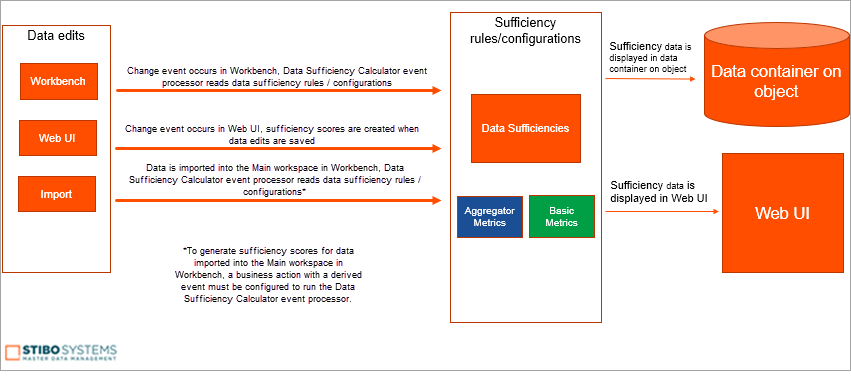Product data quality and completeness, in the form of sufficiency scores, can be obtained by configuring metrics, business rules, and specific parameters within a Sufficiency Configuration Type. These sufficiency scores, at a minimum, can:
- define data profiles that determine the quality of data
- control an item's movement through a workflow by determining certain requirements for passage
- search for items based on certain sufficiency metrics
- measure data sufficiency against a predefined syndication channel on an external system
Note: The terms 'Sufficiency Configuration Type' and 'Sufficiency' are used interchangeably throughout the documentation that addresses sufficiency scores and data quality and completeness, and both terms refer to the same functionality.
To achieve an overall better understanding of how sufficiency scores are obtained, it would be beneficial to look at an example as to how the order of actions occur to obtain a sufficiency score from a Sufficiency Configuration Type:

- A change event occurs as a result of edited data, e.g., an attribute value on a product is changed.
- If change event occurs in Workbench or data is imported, the Data Sufficiency Calculator event processor is run and reads the data and calculates scores / messages based on the settings (i.e., metrics, business conditions, etc.) that are configured within the Sufficiency Configuration Type. If change event occurs in Web UI, the sufficiency scores /messages are created when data edits are saved.
- The sufficiency data for the product is stored within a data container in the workbench and can be viewed in the Sufficiency panel in the Web UI.
Note: While sufficiency scores can be viewed within data containers in the workbench, data sufficiency messages within the workbench are not human-readable, and should only be considered as an indicator that messages have been processed. These values are human-readable within the Web UI.
Prerequisites
Because there are several different features that work together to deliver sufficiency scores, separate topics have been created to make the process as clear and concise as possible. To navigate through the process of creating sufficiency scores based on product data quality (and more precisely, obtaining sufficiency scores via a Sufficiency Configuration Type), it is recommended that users follow the order of steps listed below when creating a sufficiency for the first time:
-
Create the metrics that will be used within the sufficiency.
Metrics are an essential element of sufficiency scores, and having a firm grasp in understanding how metrics work, both separately and combined with other metrics, is crucial to the success of obtaining accurate and usable sufficiency scores. For more information, refer to the Metrics topic here.
-
Create and configure the Sufficiency Configuration Type.
The Sufficiency Configuration Type is where metrics, business actions, business conditions, selected contexts, etc., come together to create sufficiency scores for object data. For more information, refer to the Sufficiency Configuration Type topic here.
-
Configure the Data Sufficiency Calculator processing plugin.
The Data Sufficiency Calculator processing plugin works in tandem with the Sufficiency Configuration Type to calculate sufficiency scores for a given product and returns those scores to data containers in the workbench and to the Sufficiency Panel within the Web UI. For more information, refer to the Data Sufficiency Calculator Processing Plugin Parameters and Triggers topic here.
Note: Depending on how data is generated / edited, the Data Sufficiency Calculator processing plugin may not be necessary when creating sufficiency scores. Refer to the diagram at the beginning of this topic for further details.
Although it is not part of initial setup, it is recommended that users are familiar with the Sufficiency Panel, which is located in Web UI and where sufficiency scores for a given product are displayed.
For more information, refer to the following topics:
- Metrics: Metrics are an essential element of sufficiency scores, and having a firm grasp in understanding how metrics work, both separately and combined with other metrics, is crucial to the success of obtaining accurate and usable sufficiency scores.
For more information, refer to the Metrics topic here.
- Sufficiency Configuration Type: The Sufficiency Configuration Type is where metrics, business actions, business conditions, selected contexts, etc., come together to create sufficiency scores for object data.
For more information, refer to the Sufficiency Configuration Type topic here.
- Data Sufficiency Calculator processing plugin: The Data Sufficiency Calculator processing plugin works in tandem with the Sufficiency Configuration Type to calculate sufficiency scores for a given product and returns those scores to data containers in the workbench and to the Sufficiency Panel within the Web UI.
For more information, refer to the Data Sufficiency Calculator Processing Plugin Parameters and Triggers topic here.
- Sufficiency Panel: Within the Web UI, the Sufficiency panel displays sufficiency scores that represent data quality through the use of numbers, colors, and messages.
For more information, refer to the Sufficiency Panel topic here.
Below, you will find resources on sufficiencies and the privileges needed to enable them:
|
Functionality |
Privileges |
Topics |
|---|---|---|
|
Sufficiency Indicators |
Maintain Data Container Type Additionally, you will need to have the necessary privileges to edit attributes. |
Refer to the Product Editor Screen topic in Web User Interfaces documentation here. |
|
Sufficiency Panel |
Maintain Data Container Type View Setup Group View Setup Entity |
Refer to the Sufficiency Panel topic here. |
|
Calculating and Viewing Sufficiency Scores |
Create data container Modify metadata for product (property value) (also translate) |
Refer to the Sufficiency Configuration Type topic here. |
|
Setting Up Privileges |
Follow instructions to set user privileges. |
Refer to the Setting Up Privileges Example topic in System Setup documentation here. |
|
Data Sufficiency Calculator Processing Plugin Parameters and Triggers |
Users creating event processors needed for this calculator will need adequate privileges. |
Refer to the Action Sets section (here) and the Users and Groups section (here) in the System Setup documentation. |